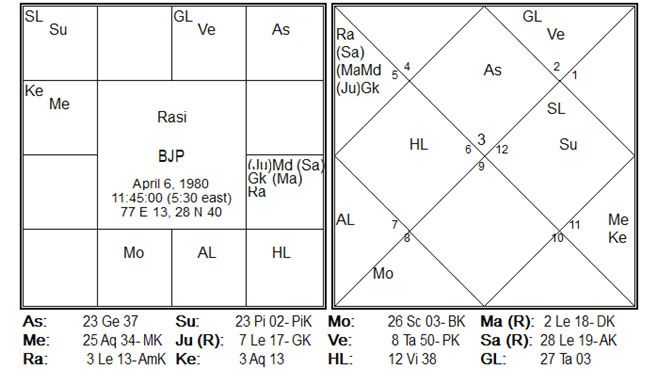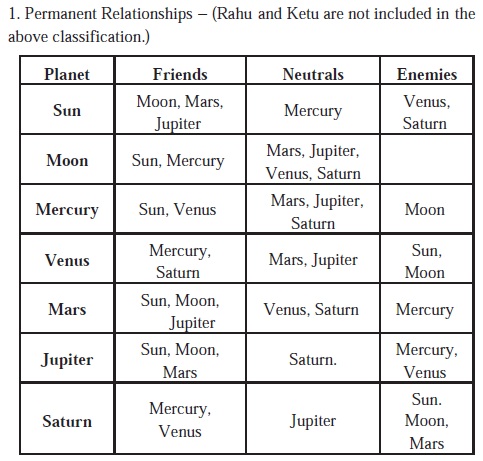Junia wrote:
PART ONE
------------------------------------------------------------------
Hi again.
Today I am going to talk about the basics in Vedic Astrology (Indian Astrology for those who are unfamiliar with it) This I think is a more complex type of astrology than the western, but there are also some similarities, therefore, I am not going to go through all things that is similar to western Astrology, because that will a waste of time. Instead, I will link to the Western Astrology forum whenever I will talk about something that I have already written in that forum. Since I am new to Vedic Astrology myself, I am not sure I will uncover everything that is needed, but I will do my best. At least this is so you can get a glimpse of how Astrology in general works. And as always, you are free to bring some ideas to the table whatever you also want me to talk about.
So... LET'S BEGIN.
------------------------------------------------------------------
Planets
I have already talked about planets in the other forum [link], but I am going to say this. In Vedic astrology, the in general used planets are only the inner planets, also called the personal planets, and the karmic points Rahu and Ketu (North Node and South Node). So therefore, the planets are:
Sun, Moon, Mercury, Venus, Mars, Jupiter, Saturn, Rahu & Ketu.
And that's IT.
------------------------------------------------------------------
The chart and the house system
(For those of you who don't know the house system in westen astrology, here's the [link] for it.)
First of all, let's look at the overall chart that ha the same appearance as the Western Chart (The circular one). It is called the sidereal chart (The western one is the tropical chart).
They look exactly the same besides one important difference. The sidereal chart's signs are about 23 degrees and 50 minutes AFTER the tropical chart. That means that if you are an Gemini sun in western astrology, the chance is very big that you are a Taurus sun in Vedic astrology, and so on.
Now, let's take a look at a chart that is very typical for the Vedic Astrology, the Lagna Chart.
They have two types of looks, one is called the Northen Indian Chart and the other one The Southern Indian Chart. They look like this:

They function exactly the same, it is only their looks that differ. Choose whichever you feel more comfortable with, I myself prefer the Northern Indian Chart, so therefore I am going to focus in this one in this tutorial.
How does this chart work then? First, you have to know the ascendant sign from the circular chart. If you know that, put the the number of that sign in the top box of the chart. That stands for the first house. Don't know which number corresponds to your sign? Here's a guide:
1. Aries
2. Taurus
3. Gemini
4. Cancer
5. Leo
6. Virgo
7. Libra
8. Scorpio
9. Sagittarius
10. Capricorn
11. Aquarius
12. Pisces
After that, all the other numbers will automatically go in each box counter-clockwise. This is called the whole houses system. The difference between whole-house system and the house-system that is in Western Astrology is that in the Western type, one sign can have two or maybe even three houses in each other because the whole house system is uneven. So one sign can go with two houses, and another can go with zero houses.
In the whole house system, however, every sign correspond to exactly one house. Therefore, if you're a Libra ascendant, the chance is 100 % that your Sagittarius is in your third house, for example.
So when you look at these types of charts, you see a lot of numbers in them. They are NOT the house's numbers, if you thought that. They correspond to THE SIGNS. Do not mix these two up. The houses are always in this position:

If you want to know what each house means, look at this [link] and scroll down to that section.
Now, which house does the planets go into? That depends what sign they are in the circular chart, and not the house (in the circular chart). Take an example. If you're a libra ascendant, that means scorpio is your second house in lagna chart. But if let's say jupiter is in scorpio in third house in circular chart, that means that in lagna chart, your jupiter is in second house, because it is in scorpio, instead of the third house.
------------------------------------------------------------------
Aspects
Aspects are very different in Vedic Astrology from the Western astrology. Instead of exact degrees to get some angles between planets, you make aspects between the houses instead. You simply count as many steps (houses) from whatever that planet that you want to look at as mentioned.
If we want to see (for example) what Saturn aspects to, and want to count 3 steps from that house, and if Saturn is in the 4th house, then you will count 4, 5, 6, so you land on the 6th house. You always count the house that the planet is already sitting in inclusively.
What types of ascects is there then? Well, there exist conjunction, which is when two planets sit in the same house (1 step apart), then mutual aspect, which is 7 houses apart or directly opposite houses, and then there are some additional aspects for some of the planets. Here's the list:

When a planet affect another planet, for example if saturn i in the 4th house and venus is in the 6th house, that means that saturn looks at venus, it means that saturn affects venus, but not that venus affect saturn.
------------------------------------------------------------------
Elements and modalities
This I think is the same as the Western Astrology, so I am only going to leave you with a [link] on this part.
------------------------------------------------------------------
Planetary rulerships
The big difference in planetary rulership between Western Astrology and Vedic Astrology is that we don't count in the outer planets Neptune, Uranus and Pluto in Vedic Astrology. Therefore, they don't rule any signs or houses (Westick to signs for now, but they also rule houses)
So here's a picture for the signs that each planet rules over (remember, every planet rules over two signs, except for sun and moon that only rules over one sign each):

------------------------------------------------------------------
I am going to fill in more, but right now I want to take a break.
PART ONE
------------------------------------------------------------------
Hi again.
Today I am going to talk about the basics in Vedic Astrology (Indian Astrology for those who are unfamiliar with it) This I think is a more complex type of astrology than the western, but there are also some similarities, therefore, I am not going to go through all things that is similar to western Astrology, because that will a waste of time. Instead, I will link to the Western Astrology forum whenever I will talk about something that I have already written in that forum. Since I am new to Vedic Astrology myself, I am not sure I will uncover everything that is needed, but I will do my best. At least this is so you can get a glimpse of how Astrology in general works. And as always, you are free to bring some ideas to the table whatever you also want me to talk about.
So... LET'S BEGIN.
------------------------------------------------------------------
Planets
I have already talked about planets in the other forum [link], but I am going to say this. In Vedic astrology, the in general used planets are only the inner planets, also called the personal planets, and the karmic points Rahu and Ketu (North Node and South Node). So therefore, the planets are:
Sun, Moon, Mercury, Venus, Mars, Jupiter, Saturn, Rahu & Ketu.
And that's IT.
------------------------------------------------------------------
The chart and the house system
(For those of you who don't know the house system in westen astrology, here's the [link] for it.)
First of all, let's look at the overall chart that ha the same appearance as the Western Chart (The circular one). It is called the sidereal chart (The western one is the tropical chart).
They look exactly the same besides one important difference. The sidereal chart's signs are about 23 degrees and 50 minutes AFTER the tropical chart. That means that if you are an Gemini sun in western astrology, the chance is very big that you are a Taurus sun in Vedic astrology, and so on.
Now, let's take a look at a chart that is very typical for the Vedic Astrology, the Lagna Chart.
They have two types of looks, one is called the Northen Indian Chart and the other one The Southern Indian Chart. They look like this:

They function exactly the same, it is only their looks that differ. Choose whichever you feel more comfortable with, I myself prefer the Northern Indian Chart, so therefore I am going to focus in this one in this tutorial.
How does this chart work then? First, you have to know the ascendant sign from the circular chart. If you know that, put the the number of that sign in the top box of the chart. That stands for the first house. Don't know which number corresponds to your sign? Here's a guide:
1. Aries
2. Taurus
3. Gemini
4. Cancer
5. Leo
6. Virgo
7. Libra
8. Scorpio
9. Sagittarius
10. Capricorn
11. Aquarius
12. Pisces
After that, all the other numbers will automatically go in each box counter-clockwise. This is called the whole houses system. The difference between whole-house system and the house-system that is in Western Astrology is that in the Western type, one sign can have two or maybe even three houses in each other because the whole house system is uneven. So one sign can go with two houses, and another can go with zero houses.
In the whole house system, however, every sign correspond to exactly one house. Therefore, if you're a Libra ascendant, the chance is 100 % that your Sagittarius is in your third house, for example.
So when you look at these types of charts, you see a lot of numbers in them. They are NOT the house's numbers, if you thought that. They correspond to THE SIGNS. Do not mix these two up. The houses are always in this position:

If you want to know what each house means, look at this [link] and scroll down to that section.
Now, which house does the planets go into? That depends what sign they are in the circular chart, and not the house (in the circular chart). Take an example. If you're a libra ascendant, that means scorpio is your second house in lagna chart. But if let's say jupiter is in scorpio in third house in circular chart, that means that in lagna chart, your jupiter is in second house, because it is in scorpio, instead of the third house.
------------------------------------------------------------------
Aspects
Aspects are very different in Vedic Astrology from the Western astrology. Instead of exact degrees to get some angles between planets, you make aspects between the houses instead. You simply count as many steps (houses) from whatever that planet that you want to look at as mentioned.
If we want to see (for example) what Saturn aspects to, and want to count 3 steps from that house, and if Saturn is in the 4th house, then you will count 4, 5, 6, so you land on the 6th house. You always count the house that the planet is already sitting in inclusively.
What types of ascects is there then? Well, there exist conjunction, which is when two planets sit in the same house (1 step apart), then mutual aspect, which is 7 houses apart or directly opposite houses, and then there are some additional aspects for some of the planets. Here's the list:

When a planet affect another planet, for example if saturn i in the 4th house and venus is in the 6th house, that means that saturn looks at venus, it means that saturn affects venus, but not that venus affect saturn.
------------------------------------------------------------------
Elements and modalities
This I think is the same as the Western Astrology, so I am only going to leave you with a [link] on this part.
------------------------------------------------------------------
Planetary rulerships
The big difference in planetary rulership between Western Astrology and Vedic Astrology is that we don't count in the outer planets Neptune, Uranus and Pluto in Vedic Astrology. Therefore, they don't rule any signs or houses (Westick to signs for now, but they also rule houses)
So here's a picture for the signs that each planet rules over (remember, every planet rules over two signs, except for sun and moon that only rules over one sign each):

------------------------------------------------------------------
I am going to fill in more, but right now I want to take a break.



 0
0 0
0 0
0 0
0 To join the forums you need to be logged in.
To join the forums you need to be logged in.














 14
14




